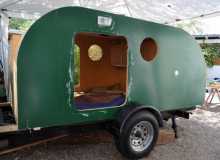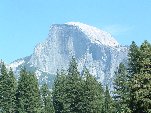Agree with all of the above, but a slight change in how ours was done is worth mentioning. Since wood & aluminum will expand at different rates, I didn't use contact cement on the entire panel for attachment.
We used small temporary blocks (with a 1/8" deep saw kerf notch) along the bottom edge, to hold then bottom edge of the panel. A solvent based contact cement was run around the perimeter at the top & sides about 2" wide, which would act as a clamp for holding the panel
after it was trimmed to size. The outline of the camper was traced along the top & sides of the panel on the back side with a magic marker. The panel was trimmed (face down) on a pair of saw horses & 2 - 2x4's were used to support the aluminum (we used .040" for the sides & top). Be careful not to scratch the face, ours was green pre-finished sign panel. An oversize panel was the result, with about 1/8" of meat standing proud, to trim for the entire panel, top, sides & bottom. The contact cement did its job holding the panel in place long enough to trim the outline at the top & sides (actually, it's the front & back). The last trim was done along the bottom edge, once the small blocks were removed. Make sure to drill out for the lights if you have them so wires can run through the panel prior to attaching the panel.
I used a 1/2" carbide cutter with the bearing on the bottom (flush cut bit), which acts as a guide on the body of the camper. If it's only about 1/8" to trim & slow passes are made, the bit won't clog with soft aluminum. If there's too much aluminum edge to trim, it will start to heat the cutter & aluminum will clog the cutter's flutes. It's miserable to have to stop & clean the bit, so keep the trim as small as possible. The reason I didn't glue the entire surface was due to the difference in expansion (wood & metal) between the substrate & finished aluminum. The aluminum "floats" on the side of the camper, but it's held in place by the metal trim along the top, front, back, bottom & doors & windows in our version. I was concerned about expansion, since the trailer lived at the time in Tucson, where it's not unusual to have the sides too hot to touch in the summer & nights in winter are down into the 20's at times. When it's very hot outside, there's a small amount of "oil can" showing on the sides, but at night it shrinks back & lays flat.

This has held up very well over a few years & many miles of towing. There's not one correct way to attach the metal, but it's easier or harder, depending on how many hands are available & the approach!

 Danny
Danny 
 Danny
Danny 







